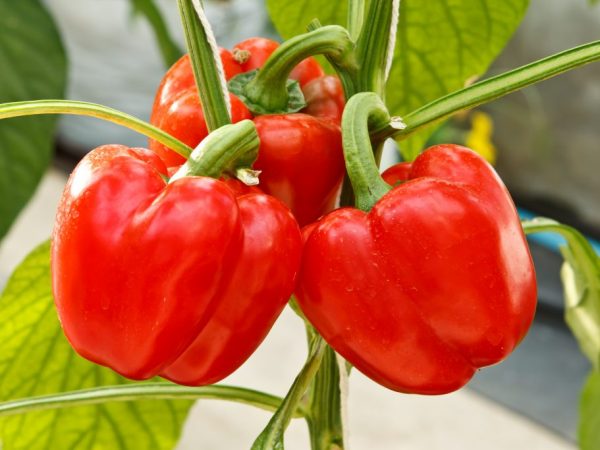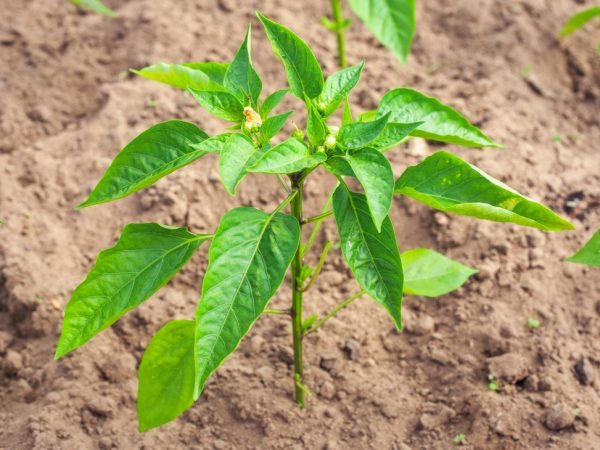Pepper variety Jupiter
Pepper Jupiter F1 is a popular hybrid developed in the 90s in the Netherlands.

Pepper variety Jupiter
Characteristics of the variety
Pepper Jupiter F1 was named after the largest planet in the solar system due to its large size. At the moment, this hybrid is quite popular in the pepper market due to a number of properties:
- low price of seeds;
- high stress resistance (tolerates drought relatively well, transportable);
- qualitative commercial characteristics of the fetus;
- good immunity to a number of diseases;
- mid-early ripening;
- increased productivity.
Description of the bush
The Jupiter pepper bush has an umbrella-like shape with a small depression in the center, which protects the fruit from sunburn. This hybrid belongs to undersized: it reaches no more than 60 cm in height.
It is less susceptible to diseases, does not require careful maintenance. It is characterized by a semi-spreading bush with medium, dark green leaves.
Description of fruits
Pepper Jupiter F1 has the following fruit characteristics:
- cuboid shape;
- weight above average (varies from 90 g, can even reach 300 g);
- easy portability of transportation;
- deep red color;
- thick walls (about 10-11 cm);
- the skin is quite dense, has a waxy coating;
- juicy and crunchy flesh, sweet taste and versatility in any culinary dish.
Care
Seedling
Since the ripening period of the Jupiter F1 hybrid is about 78 days, it is worth taking up its seedlings already in late January or early February.
To begin with, the seeds need to be treated with fungicides to prevent the appearance of diseases, and growth stimulants. You do not need to soak the seeds. After such treatment, the speed of seed germination and their quality are significantly increased.
If the crop is grown indoors (for example, in a greenhouse), after the first leaves appear, the plants are planted in different pots. This procedure has a small drawback: it causes a slight delay in the development of the plant after irritation of the delicate root system of the pepper. To save time, seeds are immediately planted in separate pots.
Open ground transplant

The plant does not need to be shaped
After about 50-60 days after planting the seedlings, the plants are transplanted to ready-made beds in the greenhouse or to open ground.
Jupiter F1 does not need to form a bush and remove flowers. If necessary, you can only cut off weak or sterile shoots so that they do not interfere with the development of others.
The bushes love warmth very much. When growing them in colder climates, it is worth building a temporary greenhouse. For this, you can use a film.
Watering
After the onset of heat, it is important to keep the soil moist at all times. To do this, it needs to be watered regularly and abundantly. This is a prerequisite for high-quality growth and development of fruits.
Fertilizers
Before, during and after the flowering period of the bushes, you should not forget about fertilization.Preference is given to phosphorus-potassium minerals and various organic dressings.
Pests and diseases
Diseases
The variety is immune to gray rot and downy mildew.
Jupiter is susceptible to the tobacco mosaic virus. The consequence of the disease is the risk of losing most of the crop, therefore, attention must be paid to its prevention. It is quite simple to recognize it: the leaves of the affected plant acquire an unusual marble pattern. This virus destroys chlorophyll, thereby completely stopping the process of photosynthesis necessary for plant development.
There are a number of other diseases that threaten Jupiter F1. Phytoplasmosis or Stolbur bush appears due to the effects of microorganisms. This disease is spread by insect pests. In the early stages, the leaves of the bush curl and dry out, and over time, the entire plant dies. Insect vectors should be controlled to prevent the possibility of this disease. If any of the plants in the seedlings gets sick, they destroy it. After harvesting, disinfect all equipment.
If the planting is too dense and the greenhouse is poorly ventilated, there is a risk of infection of the peppers with a fungal disease called Blackleg. When this disease appears, the lower part of the stems of the bush turns black and then rots, which leads to the death of the entire plant. If a black leg is found, the bush is watered with a solution of potassium permanganate.
Pests
Aphids suck sap from the leaves, which leads to the drying out of the plant and its underdevelopment. To combat aphids, it is necessary to constantly ventilate the greenhouse room, use wormwood tincture and the preparation "Phosbecid" for spraying diseased plants.
For species that are grown in a greenhouse, a spider mite is dangerous. It lives under the leaves of the plant. The leaves of plants affected by the pest become covered with spots, and after a while they dry out and die. Using pesticides and cleaning up plant debris can help control this insect.
Conclusion
Jupiter sweet peppers are a good choice for those who are willing to be patient for the sake of results. This hybrid does not require constant maintenance and has amazing characteristics and taste, which makes it indispensable in the kitchen.


